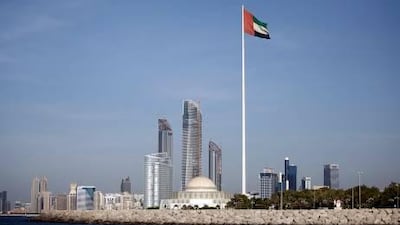Abdullah Mohammad Al Maainah had no idea that his design for the national flag had been selected until it was hoisted high above Mushrif Palace in Abu Dhabi.
The few designs that had been nominated from 1,030 entries had appeared in local newspapers, but the photos were in black and white, and Mr Al Maainah could not recognise the green, white, red and black colours that marked his design.
On December 2, 1971, the day that the Emirates unified, his winning flag was raised. One was hoisted at the palace in the capital and the other at Union House in Dubai.
But no one bothered to contact Mr Al Maainah, who was then only 19.
"I didn't know that my flag was chosen until I ran to the Mushrif Palace and from behind its fence, I stood on my toes and peeked," he said. "There was no wind that day, so I waited until there was a draft to make sure that the flag up there at the pole was mine."
When the breeze finally came and he could see the full flag, he was on top of the world.
"I can't describe to you that feeling," said Mr Al Maainah, who is now 59 and the country's newly appointed ambassador to Chile.
It was several months later that he received official notice of his winning entry, and there was no major ceremony or any festivities. The country was busy establishing itself.
Mr Al Maainah, an Emirati from Abu Dhabi, was simply thanked and received the prize for winning the competition: 4,000 riyals. The UAE dirham had not yet been introduced.
"At the time, it was like receiving 40,000 dirhams! But I didn't care about the money, I was just so happy that one of my designs won," he said.
As a diplomat, Mr Al Maainah has travelled across the world, to the farthest corners of the globe. Wherever he has gone, he has been closely accompanied by the flag he designed.
"It never leaves my side," he said. "I can't help but smile whenever I see the flag. I feel a great honour and pride each time I am photographed with it."
Three months before the UAE united, Mr Al Maainah saw an advertisement in Al Ittihad newspaper, seeking submissions for a flag. The advertisement came out of Sheikh Zayed's royal diwan, and when Mr Al Maainah stumbled upon it, it was only two days before the deadline.
He rushed and got rolls of colourful paper, a photo album, scissors and a case of measuring tools.
All his designs had the same colours but in different angles and shapes. The colours were not just a coincidence.
"Sometimes people have mistaken the UAE flag for another country, because it has the same colours as other Arab countries that adopted the pan-Arab colours of the 1916 Arab revolution," said Mr Al Maainah. Black represents the early years of Islam, which saw many wars as it spread across the Middle East during the time of the Prophet Mohammed and the first two caliphates: the Umayyads based in Damascus followed by the Abbasids based in Baghdad. The latter's rule continued from 750AD to 1258AD, and reached as far west as modern-day Algeria to as far east as India.
Green represents the Fatimids Caliphate, which ruled out of Egypt from 909AD to 1171AD over an area that spanned all of North Africa, the west coast of the Arabian Peninsula, the Levant, as well as Malta and Sicily.
Red was the colour of the Ottoman flag, and is often said to be symbolic of sacrifice and blood.
White has several meanings, from peace to purity to charity. It is the colour for peace across the world, and a white flag was raised after the Prophet Mohammed's first victory on the battlefield, in the Battle of Badr, when he overpowered his opponents in Mecca.
"But meanings change over time, and my own reasons for picking those colours are driven from a more local stance," he said.
For him, black stands for the oil that helped transform his country. Green is for fertility and its green gardens.
"And white and red were already present in separate emirate flags, so I added on what was already there to signify our expansion into a unified entity," he said.
rghazal@thenational.ae

Teen who designed UAE's national flag was 'in a flutter'
Abdullah Mohammad Al Maainah had no idea that his design for the national flag had been selected until it was hoisted high above Mushrif Palace in Abu Dhabi.
Most popular today
